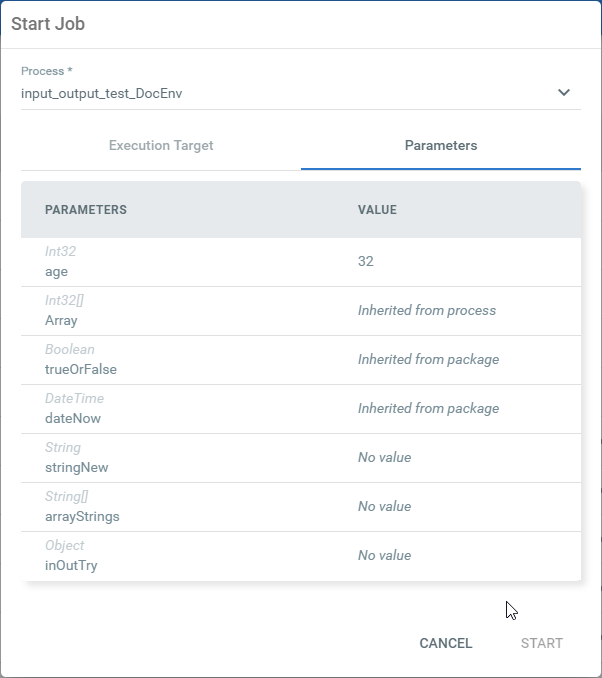We have exposed the In and Out arguments you are already used to in Studio, as a way to seamlessly integrate the tools you use, such as various DCMs or BPMs. This means that any process you create can now receive input parameters through the Orchestrator API or interface, as well as return an output to all of the aforementioned. Last but not least, this is a stepping stone in linking processes together. This extensibility helps you better integrate UiPath in your company’s ecosystem.
Important!
Only the In, Out, and In/Out arguments of the
.xamlmarked as Main in Studio are exposed to other apps.
The arguments are saved in theproject.jsonof a project.
At design time, in Studio, the way you configure your project to accept In or Out arguments, with or without default values, enables you to use them in other third-party apps or Orchestrator. You can only make use of input and output parameters in Orchestrator and other third-party apps if you had added the corresponding arguments in your Studio project beforehand. If no arguments have been added in Studio, the following message is displayed: "Input parameters are not defined for this version.".
The In, Out, or In/Out arguments of a project become input and output parameters when published to Orchestrator. Please note that for In/Out arguments two different parameters are created and displayed in Orchestrator, an input and an output one, with the same name.
Providing Parameter Values
Values can be provided only to input parameters, either using Studio, Orchestrator or the Orchestrator API as follows:
Studio
As default values, when creating the arguments. A short example can be found here. A default value provided for an argument in Studio can be overwritten in Orchestrator, both at process or job level.
Important!
Default values provided for In arguments in Studio are not displayed in Orchestrator, at any level.
Orchestrator
- At process level - in the Parameters tab of the View Process window, as explained here.
- At job level - in the Parameters tab of the Start Job window, as explained here.
- At schedule level - in the Parameters tab of the Add Schedule window, as explained here.
Note:
A value provided for an input parameter at process level in Orchestrator is kept when you update the package, as long as the new package version does not concern arguments' definition.
If you provide values for input parameters in Orchestrator, please note that they have to be provided in a JSON format. A few examples of how you can do this:
- String - the value has to be provided without quotation marks, such as
string; - Int32 - provide the value as you would any integer,
11; - Boolean - two radio buttons are displayed to help you select true or false;
- Double - provide the value as a floating point value, such as
3.5; - DateTime - provide the value as a valid JSON, such as
"2012-04-23T18:25:43.511Z"; - Array - provide values as valid JSON, such as
[1, 1, 2, 3, 5, 8]or["firstString", "secondString"].
Important!
Any type of In argument can be used, yet please keep in mind that only primitives are validated by Orchestrator.
Orchestrator API
- At package level - to the
/odata/Processes/UiPath.Server.Configuration.OData.SetArguments(key='key')endpoint; - At process level - as a PATCH request to the
/odata/Releases(Id)endpoint; - At job level - as a POST request to the
/odata/Jobs/UiPath.Server.Configuration.OData.StartJobsendpoint; - At schedule level - as a POST request to the
/odata/ProcessSchedulesendpoint.
Note:
For API calls, a maximum of 10,000 characters is accepted for the entire length of the JSON representation of input parameters, including argument names, all the escaped characters, spaces, brackets, and arguments values.
Displaying Parameter Values
The value of an input parameter is marked as follows:
- No value - No value was provided for the parameter at process, job, schedule, or package level (in Studio).
- Inherited from package - If the value was provided by default in Studio. This message is displayed in the Arguments window of a specific package, as well as the View Process, Start Job, and Add Schedule windows.
- Inherited from process - If the value was provided at process level (in the View Process window). This message is displayed in the Start Job and Add Schedule window. In the View Process window, the value itself is displayed.

If input or output parameters values exist, they are displayed in the Job Details window. The input values are displayed in the aforementioned window in the following cases:
- they were added at process level;
- they were added at job level.
You can also view input and output parameters at package level, in the Package Versions window. For more information, see the Managing Packages.
Important
Workflows that were created and published to Orchestrator prior to v2018.3 must be re-uploaded with a v2018.3 (or later) Robot so that the In and Out arguments of the
Main.xamlfile can be displayed.
Permissions
The following permissions are required in relation to input and output parameters in Orchestrator:
- at package level - View on Packages;
- at process level - View and Edit on Processes;
- at job level - Create on Jobs;
- at schedule level - Create and/or Edit on Schedules.
Updated 6 days ago